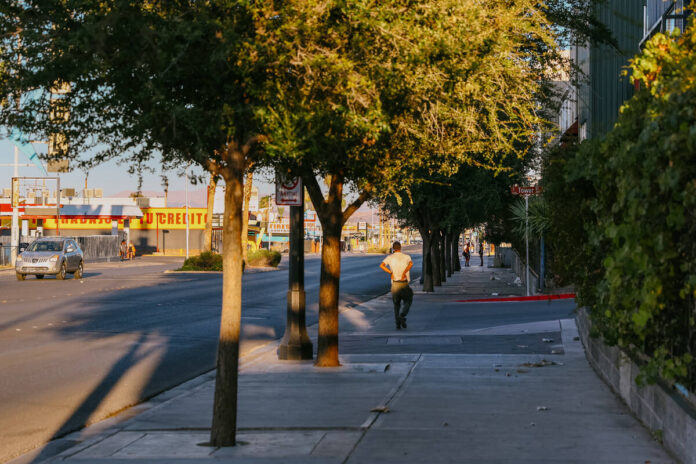Southern Nevada’s Tree Planting Efforts: A Complex Solution to Extreme Heat
As extreme heat increasingly claims lives in Southern Nevada, the region has ramped up its tree-planting initiatives in a bid to combat soaring temperatures. Yet, a recent study indicates that while trees have their merits, they may not be the panacea for daytime heat relief.
The Cooling Capabilities of Trees
Las Vegas, known for its blistering summers, witnesses a remarkable cooling effect from its trees at night, with temperature drops of nearly 35 degrees. However, during the day, these trees struggle to impact air temperature significantly. Juan Henao Castaneda, the lead author of the study and a postdoctoral researcher at the Desert Research Institute (DRI), notes, "The cooling effect of trees is usually very low." On exceedingly hot days, the trees are unable to release moisture through transpiration, limiting their cooling potential.
The Heat Crisis in Southern Nevada
Extreme heat remains a pressing challenge for Southern Nevada, exacerbated by climate change. Over 500 individuals succumbed to heat-related causes last year, with emergency room visits spiking almost 40% from 2023 to 2024. The concern over heat is palpable, even as this summer proves relatively mild compared to previous years.
The Tree Maintenance Dilemma
Urban planners have begun to recognize that trees, while valuable, cannot stand alone as solutions during extreme heat events. John Mejia, a climatologist at DRI and a co-author of the study, points out the complexities involved in maintaining these trees: “They need a lot of care… They are expensive to take care of." Many cities struggle to keep trees alive, even in more temperate climates, raising questions about their viability in a desert environment.
Nighttime Benefits in Urban Heat Islands
One notable benefit of trees that cannot be overlooked is their cooling effect during the night. This nighttime relief plays a critical role in reducing the cumulative effects of extreme heat on the human body, especially when nights fail to provide necessary respite from daytime temperatures. Ariel Choinard, coordinator of the Nevada Heat Lab at DRI, emphasizes that while trees might not be the ultimate solution, they deliver significant relief during sweltering nights.
The City’s Tree Planting Goals
To tackle rising temperatures, Las Vegas has ambitious plans. The city intends to plant 60,000 trees by 2050, while initiatives from UNLV’s Las Vegas Urban Forest Center and nonprofit Impact NV aim to add 3,000 trees by 2028 and 100,000 trees by 2032, respectively. Given that Las Vegas is recognized as the second-fastest warming city in the U.S., these goals reflect a proactive stance against urban heat islands—areas heavily impacted by pavement and limited green spaces.
Diverging Perspectives on Urban Forestry
Research indicates that Las Vegas might enjoy more substantial cooling benefits from trees than other hot cities. Peter Ibsen, a U.S. Geological Survey research ecologist, asserts that trees are essential in the heat mitigation toolkit. He advocates for strategic planning regarding where trees are planted to maximize their shade potential, highlighting that while trees assist in combating heat, they also contribute to urban biodiversity and aesthetic value.
Adaptation Measures Beyond Trees
The study reiterates that trees alone will not suffice to cool cities. Other forms of heat mitigation must be adopted. Local authorities, like those in Clark County, have established cooling centers to provide temporary relief, often opening doors during extreme heat warnings.
The Future of Urban Tree Management
The challenges posed by extreme heat could hinder the survival of many tree species. A 2019 report indicated that nearly 38% of the most common plants used in local landscaping may not endure higher temperatures by 2055. Plus, community feedback has raised concerns regarding water authority policies, which may unintentionally reduce green spaces and tree coverage.
Engaging in hyperlocal studies will soon deliver more insights into tree effects in urban environments. These investigations will help in forming a comprehensive understanding of their role in heat mitigation, especially given the deep emotional connection that people have with trees.
Continued Research and Urban Planning
The ongoing research from Castaneda and Mejia aims to equip city planners with data that is pertinent to the unique circumstances of Las Vegas. New legislative measures mandate that municipalities with populations over 100,000 update heat mitigation strategies in their master plans, signaling a thoughtful approach toward future urban planning that accommodates extreme weather conditions.
Through continued investigation and community engagement, Southern Nevada seeks to construct a balanced strategy to tackle the compounding effects of heat while ensuring its urban landscape remains vibrant and livable for its residents.
